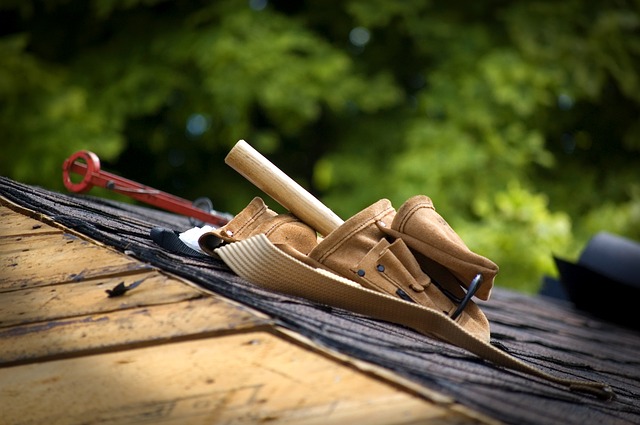Leaky Roof? Fix It Yourself with this Guide
 It's a scenario that everyone is likely to experience at least once: after heavy rain, you notice that water has mysteriously started dripping from the ceiling. Unless your plumbing has coincidentally failed during the storm, the culprit could only be a leak in your roof. For many people, the idea of climbing onto the roof to find and patch a leak falls squarely in the "professionals only" category of home maintenance. However, if you are one of the diehard DIYers who insists on tackling any project head-on, this simple guide can help you fix your roof safely and effectively.
It's a scenario that everyone is likely to experience at least once: after heavy rain, you notice that water has mysteriously started dripping from the ceiling. Unless your plumbing has coincidentally failed during the storm, the culprit could only be a leak in your roof. For many people, the idea of climbing onto the roof to find and patch a leak falls squarely in the "professionals only" category of home maintenance. However, if you are one of the diehard DIYers who insists on tackling any project head-on, this simple guide can help you fix your roof safely and effectively.
Are You Sure?
First of all, those people that hire a professional roofer have a point. After all, repairing even minor damage can be dangerous and difficult, especially if the roof in question is sloped rather than flat. In addition, many leaks will require a professional in order to be repaired long-term. While these factors don't mean a quick repair is useless, they are things that should be considered before attempting the repair on your own.
Safety First
Although it might sound cliché, safety should always be your top priority. Given that the danger in this situation is falling off the roof, simply tying yourself to a chimney or sturdy object on the other side of the house (such as a tree) will go a long way toward minimizing that danger. The important thing here is to make sure that the object and rope can support your weight, and that there is not too much slack in the rope.
Find the Problem Area
You should have a general idea of where the leak is located based on the water damage in the house, so start by searching that area of the roof. Look for any shingles that are cracked, raised, missing, or even moldy. Leaks often form anywhere that vents or plumbing emerge through the roof, so be sure to check those as well. Sometimes the source of the water can be very difficult to find, in which case you should contact a professional before the damage gets worse.
Repairing a Flat Roof
Because flat roofs usually don't have shingles, this is the simpler repair and can be done with a store bought patch kit. After locating the spot where water is entering, first clear away any loose debris where the patch will sit. Next, apply primer to the damaged area, being sure to overlap the surrounding, undamaged area. Finally, press the patching material firmly in place and use a roller to ensure a flat, even seal. Obviously, directions for your patch kit may vary, so defer to them if you are unsure of anything.
Repairing Shingles
Replacing a broken shingle is somewhat more complicated and will require a hammer, pry bar, roofing nails, adhesive, and (of course) a new shingle. Obviously, when purchasing a new shingle, try to match the existing ones as closely as possible. Begin by lifting the damaged shingle and removing the nails that hold it in place. Once that shingle is gone, lift up the shingle that sat on top of the damaged shingle, being careful not to pull it out of the roof. Slide the new shingle under the existing one, and be sure that it is cut to the proper size for space. Use roofing nails to attach the new shingle in place and apply roofing adhesive onto the nail heads. Depending on how extensive the damage is, you may need to replace multiple shingles in the area. Be sure that all shingles are sitting flat and are secure before leaving.
Still hungry for information? For advice on fixing other types of roof leaks, check out this article. For more tips on fixing shingles, click here.
- Cheryl Bourland's blog
- Login or register to post comments
 Google+
Google+


 Information Deemed Reliable but Not Guaranteed. CENTURY 21 H.S.V. Realty is licensed in the state of Arkansas. CENTURY 21 and the CENTURY 21 Logo are registered service marks owned by Century 21 Real Estate LLC. H.S.V. Realty, Inc. fully supports the principles of the Fair Housing Act and the Equal Opportunity Act. Each franchise is independently owned and operated. Any services or products provided by independently owned and operated franchisees are not provided by, affiliated with or related to Century 21 Real Estate LLC nor any of its affiliated companies.
Information Deemed Reliable but Not Guaranteed. CENTURY 21 H.S.V. Realty is licensed in the state of Arkansas. CENTURY 21 and the CENTURY 21 Logo are registered service marks owned by Century 21 Real Estate LLC. H.S.V. Realty, Inc. fully supports the principles of the Fair Housing Act and the Equal Opportunity Act. Each franchise is independently owned and operated. Any services or products provided by independently owned and operated franchisees are not provided by, affiliated with or related to Century 21 Real Estate LLC nor any of its affiliated companies.